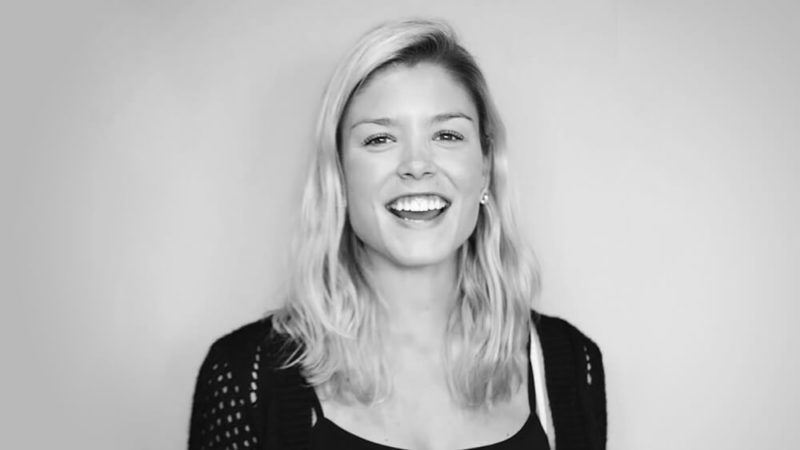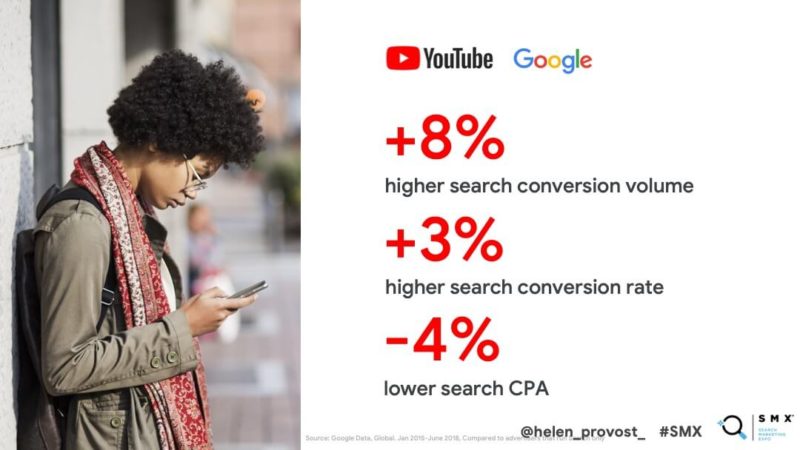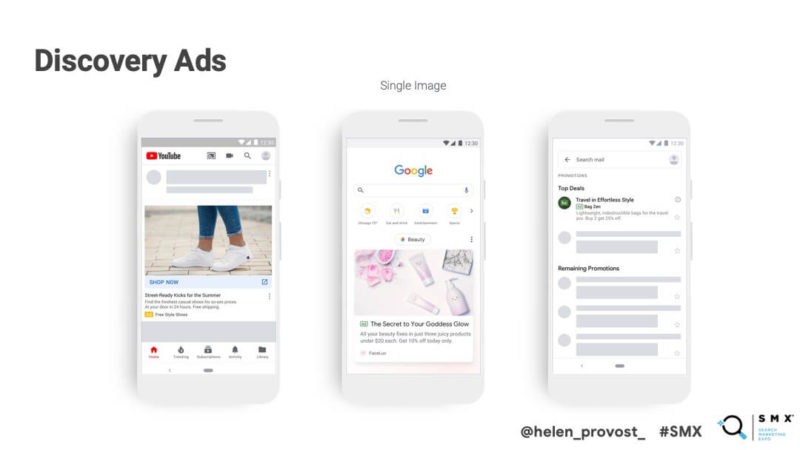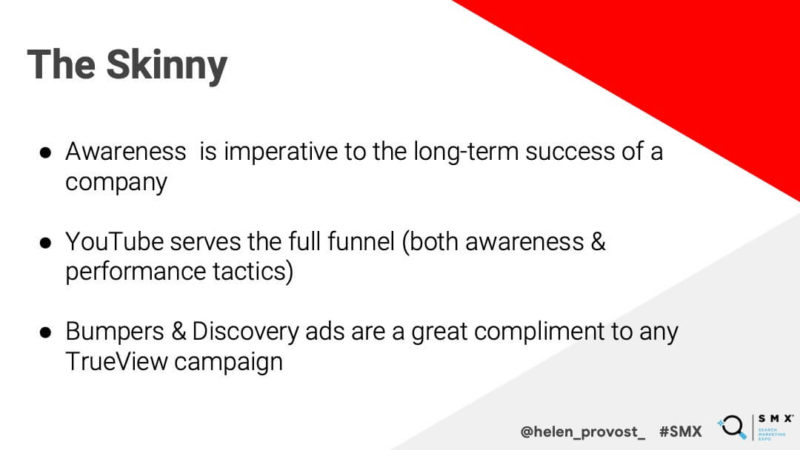SMX replay: Brand to demand, the full funnel approach
Helen Provost of Google shares how businesses can use YouTube to serve the full funnel and make use of automation to deliver their messaging.
Being present at every turn of your customers’ path to purchase can help you guide their journey. During her Insights session at SMX Advanced, Helen Provost, account manager at Google, discussed using YouTube ads in tandem with Google search ads to generate more awareness for your brand and help users along the funnel.
You can listen to Provost’s full session above, then keep reading for her tips on getting the most out of your YouTube ad campaigns. The full transcript is also available below.

Whether you’re just starting out with YouTube ads or looking to optimize them, Provost suggests that you keep the following in mind:
- When running TrueView for Action ads on YouTube, be sure to let the auto bidding run unaltered for at least two weeks. The reason is to make sure you’re letting the machine learning systems actually learn. Every time you change your target goal, the learning process needs to start all over again.
- For bumper ads, YouTube’s six-second format, have your creative focus on one single theme. You’ll want to leave the viewer with a single parting thought.
- YouTube is huge on mobile, and screen size matters when creating content for it. Closeups of faces, text, and so on are key to creative success.
Insights sessions are how we deliver actionable tips and useful information from experts. Here are a few more sessions you can stream right now:
- Ashley Mo’s tips on improving your YouTube ad performance.
- Amanda Milligan’s guide on using data storytelling to earn top-tier media coverage.
- Patrick Stox’s session on SEO that Google tries to fix for you.
- Sam Marsden’s approach on building dashboards that inform and persuade.
If you found these sessions informative, consider attending them live on November 13-14, at SMX East in New York.
The full transcript.
Introduction by George Nguyen: Branding is a top priority for marketing teams everywhere, but sometimes, the messaging that conveys our brands can get pigeonholed in a particular channel or delivery vehicle.
And, sometimes the customers’ path to purchase takes a few unexpected detours. Making sure that your brand is there — at every turn of that path — can help you guide their journey no matter what stage of the funnel they’re in.
This is the Search Engine Land podcast, I’m your host George Nguyen and you’re about to hear from Helen Provost, an account manager at Google.
During her Insights session at SMX Advanced, she spoke about using YouTube ads in tandem with Google search ads to generate more awareness for your brand and serve the full funnel as well as how to use Google’s automated features to build out and optimize your campaigns.
Before I hand it off to Helen, I encourage you to check out our other SMX replays (after you listen to this one, of course); they feature insights on creating informative dashboards, earning top-tier media coverage, SEO that search engines try to fix for you and much more. All of that can be heard on the Marketing Land SoundCloud stream, and the full articles and transcripts are available on SearchEngineLand.com — just search SMX replay. And now, here’s Helen…
Helen Provost, Google Ads account manager: What up, SMX Advanced? Today we are going to be talking about brands to demand — specifically the evolution of branding, the full-funnel approach. My name’s Helen provost and like any good marketer, my favorite thing to talk about is myself. So, we will start there.
Boston girl born and raised, big Patriots fan. Yes.
Without further ado I’d thought we’d start out with a little pop quiz here. So, a good product sells itself — true or false? Everyone’s right. We all win — it’s half true. The best product will always win, but only if people know about it. I repeat: the best product will always win, but only if people know about it.

Brand building gives greater returns to the bottom line. There was a McKinsey study published a few years back that showed that strong brands prevail in both the bull and the bear phases of the market and at an increasing margin. The world’s top 40 brands ranked by Interbrand’s annual best global brand study has continuously beaten traditional benchmark since it was first published in 2000. So, benchmarks like the S&P 500. Convincing, right?
So, how many of you use at least one of these services? Keep your hands up. Look around. We all inherently love video. That hasn’t changed, but the way we consume video has changed and that’s largely due to YouTube. How many of you were watching YouTube back in 2004? Hmm. Interesting. YouTube launched in 2005 — early adopters.
So, we just announced this a couple of weeks ago at Google Marketing Live. I don’t know how many of you were there. But we now have two billion monthly logged in viewers on YouTube and that’s greater than the populations of China, the United States and Brazil combined. And there’s virtually a topic for everyone on YouTube, no matter if your into vintage cars or working out or you know, cooking. I’m personally into Binging with Babish. I watch all of the time — all 200 and some odd episodes.
And, increasingly YouTube is where people are going to shop. Did you know that 40% of people purchase products that they first discover on YouTube? Considering YouTube’s massive scale, this is an opportunity that you can’t afford to miss. Video has so much potential and I know that there is a lot of you in this room who have yet to lean in yet, but I’m here to tell you that things have changed. But as performance marketers, I know, you know, it can be kind of scary, like video’s expensive to create. It’s historically been really hard to show ROI and overall complicated to deal with and that’s fair. But video used to sit comfortably at the top of the funnel, right? And it wasn’t used as anything more than a brand building strategy, rarely daring to go within the realm of direct response.
Unless you watch late night infomercials like Flowbee; do you guys remember this? This is actually still a product. For those of you who are not familiar, it’s an attachment that you can put on your vacuum cleaner so that you can, like give yourself a haircut or something. It’s kind of odd. But really the only way you could get someone to take an action with video previously was to get them to watch it and then maybe get them to call a phone number afterwards. You couldn’t optimize mid-flight, you couldn’t measure impact beyond reach. Anyone with a conversion mindset, aside from Flowbees marketing team, was highly skeptical of video.
But video’s come a long way since the days of Flowbee and we want to help you seize this tremendous opportunity. Thanks to better technology and a more interactive video format, you can finally hold video accountable for driving results that matter most to your business. Whether you’re trying to generate leads, get someone into your store, get them to purchase something online — when done correctly, video can drive results that matter to your business. You can inspire, drive consideration and, at the end of the video, provide a seamless path to purchase.
I’d like to quickly show a couple of examples of companies that have found success using YouTube.

So the first one is Marley Spoon. This is a fast growing startup — Martha Stewart company, and they wanted to start leveraging video to be there throughout the whole customer journey. So, with a meal delivery service heating up, Marley Spoon was hungry for efficient ways to simultaneously raise brand awareness while they also raise their subscription base. They created a YouTube campaign that was a mix of brand awareness and also getting people to site at the end of the video.

The results validate YouTube’s unique ability to stay with the consumer throughout the whole customer journey. There was a 25% increase in brand awareness, a 49% increase in ad recall and a 52% lift in subscriptions. As Marley Spoon shows us, video can drive impressive results on its own, but if you really want to turbocharge growth, I recommend you use search and video in tandem with one another to create the flywheel effect.

On average, brands who use YouTube and Google search together see an 8% higher increase in conversion volume, a 3% increase in conversion rate and a 4% decrease in target CPA. And, in fact, did you know that 80% of shoppers, switch between online search and video while researching to buy products?
I’d love to walk you through another quick example of a brand that utilized YouTube and United Airlines is a great example of that. So, I think the average American gets something like only 10 days of vacation per year. So it’s, you know, no big surprise that people who are booking a vacation, we do a lot of research and we do our due diligence. Historically, United Airlines was using YouTube just as an upper-funnel brand awareness tactic but they decided to see if they could take that to the next level — and they did. Using a target CPA, they drove 17,000 booked flights. That’s pretty impressive, right?
And what about shorter form ads? Everyone’s heard of bumpers, right? Or at least you’re familiar watching those six-second ads on YouTube? Those are a great way to get in front of a mobile-first world. Advertisers are challenged to make an impact despite screens being small and attention spans being short. But, you can actually create pretty compelling messaging in six seconds.
Bumper use cases: what can these be used for? They’re a great compliment to any TrueView campaign that you’re running. They can use, if you want to tease up a bigger brand message that’s coming down the pipe, they can be used directly in conjunction with your TrueView efforts and then they can be used after the fact to remarket people who have seen your ad to start with.
The Bumper Machine — does anybody know what this is? This is so cool; this is like my favorite thing that Google just released. So essentially, you know, we listened and we know that video can be kind of intimidating and it kind of seemed like it was the “cool kid’s club,” right? You can only be on YouTube if you had a big brand, but that’s not the case anymore and we wanted to make that very apparent to advertisers.
So, what we did is we created something that we call the Bumper Machine and it’s still in beta right now, but what it does is it takes your 90-second or less a video and it morphs it using machine learning into three or four six-second spots. It’s pretty impressive.
And the last tactic that I would love to highlight here for you today is, you know, being present on the YouTube home feed. And you can do that by launching discovery campaigns.

Discovery ads: those can be launched without even video assets. And all you have to do is provide images, a few pieces of creative, and then we’ll piece that together and show in impactful spots like in your Gmail inbox, on the YouTube home display and then also, of course, on the Google home feed there.

So, the skinny here: Awareness is imperative to the long-term success of any company. YouTube serves the full funnel, you can use it for both awareness and performance tactics at the same time. And, bumpers and discovery are great complement to any TrueView campaign. Thank you.
Contributing authors are invited to create content for Search Engine Land and are chosen for their expertise and contribution to the search community. Our contributors work under the oversight of the editorial staff and contributions are checked for quality and relevance to our readers. The opinions they express are their own.
Related stories
New on Search Engine Land